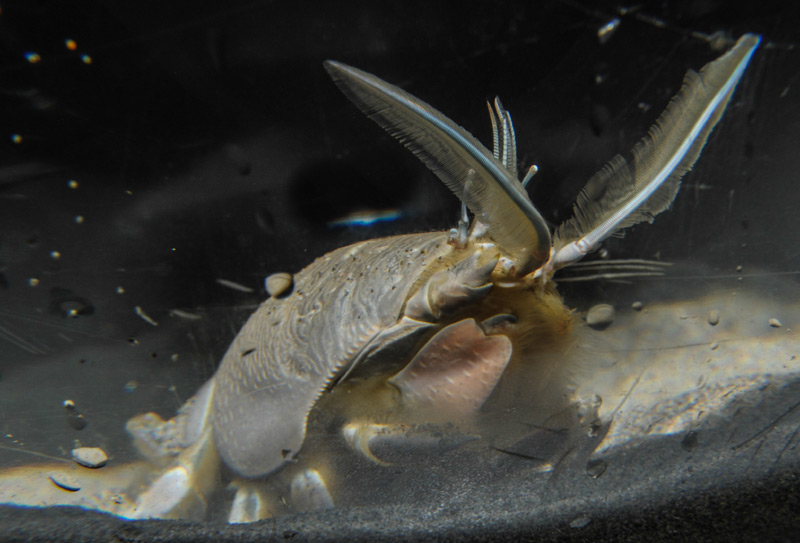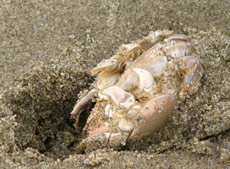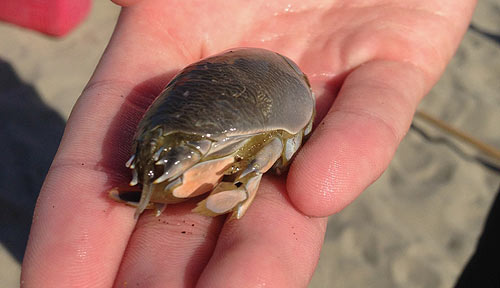Freaky Critters That Brush Past You in Tideline | Oregon, Washington Coast Science
Published 03/14/21 at 5:50 AM PDT
By Oregon Coast Beach Connection staff

(Seaside, Oregon) - They show up in summer on the Oregon or Washington coast, usually late in the season, and they get a little creepy at the tideline. (Closeup of a mole crab - all photos courtesy Seaside Aquarium / Tiffany Boothe)
They are known as mole crabs, but they don't pinch or bite. In fact, what they've got is really rather soft, actually feather-like. You’ll notice these bug-like creatures washing over your feet on any Washington or Oregon coast beach late in the season. Whether it’s Newport, Long Beach, around Coos Bay, or way down near Brookings, sometimes you can feel the sensation of dozens of little something’s zip across your feet as you’re hanging out right in the waves.
Includes exclusive listings; some specials in winter
In Cannon Beach:
Includes rentals not listed anywhere else
In Manzanita, Wheeler, Rockaway Beach:
Some specials for winter
In Pacific City, Oceanside:
Some specials for winter
In Lincoln City:
Some specials for winter
In Depoe Bay, Gleneden Beach:
Some specials for winter
In Newport:
Look for some specials
In Waldport
Some specials for winter
In Yachats, Florence
Some specials for winter
Southern Oregon Coast Hotels / Lodgings
Reedsport to Brookings, places to stay; winter deals
Curiously, they are not found far north of the Long Beach Peninsula in Washington, but they are aplenty on the southern Oregon coast. Northern Washington populations are from larvae that ride the current up the west coast.
According to Tiffany Boothe of Seaside Aquarium, instead of pinchers they have paddle-like legs which help them burrow quickly into the sand. Mole crabs swim and dig into the sand backwards - that way only their eyes are sticking out of the sand. You’ll see the waves appear to “bubble” as their vast numbers in the sands are tossed around by the tide and they struggle to burrow themselves into one spot.
Their scientific name is Enerita analoga. The phylum is Arthropoda. Class: Crustacea. Order: Decopoda, and their family is Hippidae.
True to their common name, mole crabs are related to many other crabs we know, but of course, they’re much smaller than most of the those in their little section of the animal kingdom. They’re in the same order as hermit crabs, true crabs and shrimp.
They normally live on sandy beaches in the surf zone, usually buried in the sand with the breathing antennae sticking out.
What do these little freaks of the near-deep eat?

Anyone remember Starship Troopers?
Plankton.
These little critters use a second set of antennae to fish through the water. The hairs on the antennae are so fine they can catch bacteria. They don’t fish all of the time, usually only while lounging in the surf zone when the water is a few inches deep. Primarily, they feed while buried in sand.
 Mole crabs ride in and out with the surf to maximize on feeding time. They dig themselves into the surf and wait for the receding wave. Their antennae then catch any phytoplankton coming through, and their appendages then take the catch into their teeny, tiny mouths.
Mole crabs ride in and out with the surf to maximize on feeding time. They dig themselves into the surf and wait for the receding wave. Their antennae then catch any phytoplankton coming through, and their appendages then take the catch into their teeny, tiny mouths.
Their shells – or carapaces – get about one inch to 1.4 inches in length.
Their lifespan is about 18 months maximum, usually summer through to the next summer.
Mole crabs reproduce through internal fertilization. The female must molt before reproduction can occur (this is the case with most crabs).
The female carries her eggs under the abdominal area for several months. The eggs are bright orange, and mating season is the spring.
By July, most of the males that were hatched the previous summer have died off. The females will have died off by the winter, leaving only one single generation of them on the beach. Once the winter kicks in and the sand gets too cold, they leave the beach for deeper waters.
These are popular little guys - a huge link in the food chain. Seagulls, sandpipers and surf perch make steady meals out of them. They are popular with many people on the east coast as bait for fishing. MORE PHOTOS BELOW
Oregon Coast Hotels for this event - South Coast Hotels - Where to eat - Maps - Virtual Tours
Cannon Beach Lodging
Nehalem Bay Lodgings
Manzanita Hotels, Lodging
Three Capes Lodging
Pacific City Hotels, Lodging
Lincoln City Lodging
Depoe Bay Lodging
Newport Lodging
Waldport Lodging
Yachats Lodging
Oregon Coast Vacation Rentals
Oregon Coast Lodging Specials
More About Oregon Coast hotels, lodging.....
More About Oregon Coast Restaurants, Dining.....
LATEST Related Oregon Coast Articles
Through 2 a.m. likely best, but some lights possible through dawn June 1 - 2. Space weather, astronomy
Rare Sperm Whale Stranding on N. Oregon Coast, Was Hit by Boat
Showing up near Gearhart, it will decompose naturally. Marine sciences
Coast Guard Barque 'America's Tall Ship' Coming to Portland Rose Fest, N. Ore...
Portland events: June 5 - 8; Astoria events June 13 - 15. Weather
Bright and Active Arietids Meteors May Hit Pre-Dawn Hours of Oregon, Washingt...
Look to east hour before sunrise and you may catch a show. Sciences, astronomy, weather
Why Now Could Be a Great Week for Spotting Killer Whales on Oregon Coast - Video
A good dozen documentations around Depoe Bay, Newport, Coos Bay, Bandon, Tillamook. Marine sciences
Summer Road Work, Traffic Issues Along Oregon Coast Include Astoria, Garibald...
Some daylight closures include bridges, OR 22, OR 18, OR 26, more. Travel tips. Seaside, Cannon Beach, Lincoln City. Travel tips
Pacific City Oregon Weather, 7-Day Forecasts, Live Conditions, Radar, Webcams...
Updated Constantly: Pacific City, Tierra Del Mar, Oregon Weather, Cams, Buoy Observations, Tides, Warnings - Alerts
Oregon Coast Has World's Oldest Harbor Seal, Celebrating 50 Years Soon
June 3 at Oregon Coast Aquarium in Newport. Newport events
Back to Oregon Coast
Contact Advertise on BeachConnection.net
All Content, unless otherwise attributed, copyright BeachConnection.net Unauthorized use or publication is not permitted






















































